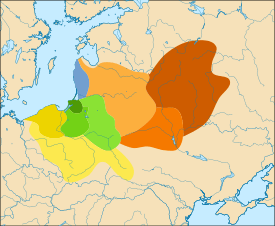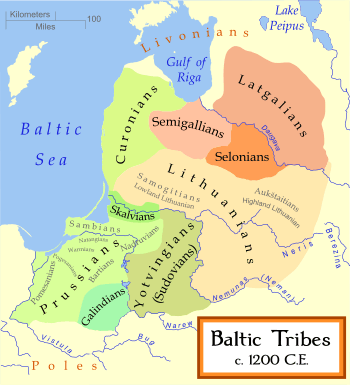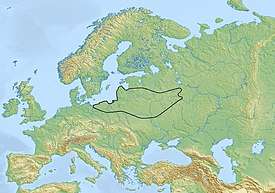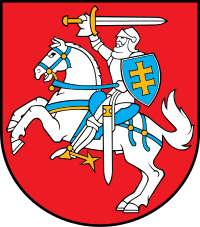Balts
The Balts or Baltic people (Lithuanian: baltai, Latvian: balti) are a group of Indo-European peoples primarily characterized as speakers of the Baltic languages.
| Total population | |
|---|---|
| c. 5.5 million | |
| Regions with significant populations | |
| Languages | |
| Baltic languages | |
| Related ethnic groups | |
| Slavs (mostly Belarusians, Kashubians and Pomeranians) |
| Part of a series on |
| Indo-European topics |
|---|
 |
|
|
Philology
|
|
Origins |
|
Archaeology Pontic Steppe
Caucasus East Asia Eastern Europe Northern Europe Pontic Steppe Northern/Eastern Steppe Europe
South Asia Steppe Europe Caucasus India |
|
Peoples and societies Indo-Aryans Iranians
East Asia Europe East Asia Europe
Indo-Aryan Iranian
|
|
Religion and mythology
Indo-Aryan Iranian Others Europe
|
|
One of the features of Baltic languages is the number of conservative or archaic features retained.[1] Among the Baltic peoples are modern Lithuanians and Latvians (including Latgalians) — all Eastern Balts — as well as the Old Prussians, Yotvingians and Galindians — the Western Balts — whose languages and cultures are now extinct.
Etymology
Medieval German chronicler Adam of Bremen in the latter part of the 11th century AD was the first writer to use the term Baltic in its modern sense to mean the sea of that name.[2][3] Before him were various ancient places names, such as Balcia,[4] meaning a supposed island in the Baltic Sea.[2]
It should not be surprising that Adam, a speaker of German, might connect Balt- with "Belt", a word he was familiar with. However, linguistics has since established that Balt means white. Many Baltic words contain the stem balt-, "white",[5] which may also refer to shallow bodies of water including marshes.
In Germanic languages there was some form of "East Sea" until after about 1600, when maps in English labeled it the "Baltic Sea". By 1840, the German nobles of the Governorate of Livonia adopted the term "Balts" to distinguish themselves from Germans of Germany. They spoke an exclusive dialect, Baltic German. For many, that was the “Baltic language” until 1919.[6][7]
In 1845, Georg Heinrich Ferdinand Nesselmann proposed a distinct language group for Latvian, Lithuanian and Old Prussian—Baltic.[8] The term became prevalent after Latvia and Lithuania gained independence in 1918. Up until the early 20th century, either “Latvian” or “Lithuanian” could be used to mean the entire language family.[9]
History
Origins
The Balts or Baltic peoples, defined as speakers of one of the Baltic languages, a branch of the Indo-European language family, are descended from a group of Indo-European tribes who settled the area between the lower Vistula and southeast shore of the Baltic Sea and upper Daugava and Dnieper rivers. Because the thousands of lakes and swamps in this area contributed to the Balts' geographical isolation, the Baltic languages retain a number of conservative or archaic features.
Some of the major authorities on Balts, such as Kazimieras Būga, Max Vasmer, Vladimir Toporov and Oleg Trubachyov, in conducting etymological studies of eastern European river names, were able to identify in certain regions names of specifically Baltic provenance, which most likely indicate where the Balts lived in prehistoric times. This information is summarized and synthesized by Marija Gimbutas in The Balts (1963) to obtain a likely proto-Baltic homeland. Its borders are approximately: from a line on the Pomeranian coast eastward to include or nearly include the present-day sites of Berlin, Warsaw, Kiev, and Kursk, northward through Moscow to the River Berzha, westward in an irregular line to the coast of the Gulf of Riga, north of Riga.
Proto-history

The area of Baltic habitation shrank due to assimilation by other groups, and invasions. According to one of the theories which has gained considerable traction over the years, one of the western Baltic tribes, the Galindians, Galindae, or Goliad, migrated to the area around modern day Moscow, Russia around the 4th century AD.[10]
Over time the Balts became differentiated into Western and Eastern Balts. In the 5th century AD parts of the eastern Baltic coast began to be settled by the ancestors of the Western Balts: Brus/Prūsa ("Old Prussians"), Sudovians/Jotvingians, Scalvians, Nadruvians, and Curonians. The Eastern Balts, including the hypothesised Dniepr Balts, were living in modern-day Belarus, Ukraine and Russia.
Germanic peoples lived to the west of the Baltic homelands; by the first century AD, the Goths had stabilized their kingdom from the mouth of the Vistula, south to Dacia. As Roman domination collapsed in the first half of the first millennium CE in Northern and Eastern Europe, large migrations of the Balts occurred — first, the Galindae or Galindians towards the east, and later, Eastern Balts towards the west. In the seventh century, Slavic tribes from the Volga regions appeared. By the 13th and 14th centuries, they reached the general area that the present-day Balts and Belarusians inhabit. Many other Eastern and Southern Balts either assimilated with other Balts, or Slavs in the 4th–7th centuries and were gradually slavicized.
Middle Ages
In the 12th and the 13th centuries, internal struggles, as well as invasions by Ruthenians and Poles and later the expansion of the Teutonic Order resulted in an almost complete annihilation of the Galindians, Curonians, and Yotvingians. Gradually Old Prussians became Germanized or some Lithuanized during period from the 15th to the 17th centuries, especially after the Reformation in Prussia. The cultures of the Lithuanians and Latgalians/Latvians survived and became the ancestors of the populations of the modern countries of Latvia and Lithuania.
Old Prussian was closely related to the other extinct Western Baltic languages, Curonian, Galindian and Sudovian. It is more distantly related to the surviving Eastern Baltic languages, Lithuanian and Latvian. Compare the Prussian word seme (zemē),[11] the Latvian zeme, the Lithuanian žemė (land in English).
Culture
| Part of a series on |
| Baltic religion |
|---|
|
|
Deities Panbaltic Perkūnas · Velnias · Dievas · Saulė · Mėnulis |
|
Festivals
|
|
Concepts
|
|
The Balts originally practiced Baltic religion. They were gradually Christianized as a result of the Northern Crusades of the Middle Ages. Baltic peoples such as the Latvians, Lithuanians and Old Prussians had their distinct mythologies. The Lithuanians have close historic ties to Poland, and many of them are therefore Roman Catholic. The Latvians have close historic ties of Northern Germany and Scandinavia, and many of them are therefore Lutherans. Irreligion is widespread. In recent times, the Baltic religion has been revived in Baltic neopaganism.
Genetics
Recent genetic research show that the eastern Baltic in the Mesolithic was inhabited primarily by Western Hunter-Gatherers (WHGs).[12] Their paternal haplogroups were mostly types of I2a and R1b, while their maternal haplogroups were mostly types of U5, U4 and U2.[13] These people carried a high frequency of the derived HERC2 allele which codes for light eye color.
During the Neolithic, increasing admixture from Eastern Hunter-Gatherers (EHGs) is detected. The paternal haplogroups of EHGs was mostly types of R1b and R1a, while their maternal haplogroups appears to have been almost exclusively types of U5, U4, and U2. Baltic hunter-gatherers still displayed a slightly larger amount of WHG ancestry than Scandinavian Hunter-Gatherers (SHGs). WHG ancestry in the Baltic was particularly high among hunter-gatherers in Latvia and Lithuania.[14] Unlike other parts of Europe, the hunter-gatherers of the eastern Baltic do not appear to have mixed much with Early European Farmers (EEFs) arriving from Anatolia.[15]

The rise of the Corded Ware culture in the eastern Baltic in the Chalcolithic and Bronze Age is accompanied by a significant infusion of steppe ancestry and EEF ancestry into the eastern Baltic gene pool.[15][12][16] In the aftermath of the Corded Ware expansion, local hunter-gatherer ancestry experienced a resurgence.[14] Haplogroup N did not appear in the eastern Baltic until the late Bronze Age, perhaps as part of a westward migration of Uralic peoples.[14]
Modern Balts have a lower amount of EEF ancestry, and a higher amount of WHG ancestry, than any other population in Europe.[17][lower-alpha 1]
List of Baltic peoples
Modern Baltic peoples
- Eastern Baltic peoples
- Latvians
- Lithuanians
- Aukštaitians ("highlanders")
- Samogitians ("lowlanders")
See also
- Eastern Baltic languages
- Western Baltic languages
Notes
- "Baltic populations carry the highest proportion of WHG ancestry of all Europeans, supporting the theory that the hunter-gatherer population of this region left a lasting genetic impact on subsequent populations."[14]
References
- Bojtár page 18.
- Bojtár page 9.
- Adam of Bremen reports that he followed the local use of balticus from baelt ("belt") because the sea stretches to the east "in modum baltei" ("in the manner of a belt"). This is the first reference to "the Baltic or Barbarian Sea, a day's journey from Hamburg. Bojtár cites Bremensis I,60 and IV,10.
- Balcia, Abalcia, Abalus, Basilia, Balisia. However, apart from poor transcription, there is known linguistic rule whereby these words, including Balcia, might become “Baltia.”
- Latvian: balti; Lithuanian: baltai; Latgalian: bolti, lit. "white".
- Bojtár page 10.
- Butler, Ralph (1919). The New Eastern Europe. London: Longmans, Green and Co. pp. 3, 21, 22, 2 24.
- Schmalstieg, William R. (Fall 1987). "A. Sabaliauskas. Mes Baltai (We Balts)". Lituanus. Lituanus Foundation Incorporated. 33 (3). Archived from the original on 7 September 2008. Retrieved 2008-09-06. Book review.
- Bojtár page 11.
- Tarasov I. The balts in the Migration Period. P. I. Galindians, pp. 96, 100-112.
- Mikkels Klussis. Bāziscas prûsiskai-laîtawiskas wirdeîns per tālaisin laksikis rekreaciônin Donelaitis.vdu.lt (Lithuanian version of Donelaitis.vdu.lt).
- Saag 2017.
- Mathieson 2018.
- Mittnik 2018.
- Jones 2017.
- Malmström 2019.
- Lazaridis 2014.
Sources
English language
- Jones, Eppie R. (February 20, 2017). "The Neolithic Transition in the Baltic Was Not Driven by Admixture with Early European Farmers". Current Biology. Cell Press. 27 (4): 576–582. doi:10.1016/j.cub.2016.12.060. PMC 5321670. PMID 28162894.CS1 maint: ref=harv (link)
- Bojtár, Endre (1999). Foreword to the Past: A Cultural History of the Baltic People. Budapest and New York: Central European University Press. p. 9. ISBN 978-963-9116-42-9.
- Gimbutas, Marija (1963). The Balts. London: Thames & Hudson.
- "Lithuanians". 1911 Encyclopædia Britannica (1 ed.). 1911.
- Lazaridis, Iosif (September 17, 2014). "Ancient human genomes suggest three ancestral populations for present-day Europeans". Nature. Nature Research. 513 (7518): 409–413. doi:10.1038/nature13673. hdl:11336/30563. PMC 4170574. PMID 25230663.CS1 maint: ref=harv (link)
- Malmström, Helena (October 9, 2019). "The genomic ancestry of the Scandinavian Battle Axe Culture people and their relation to the broader Corded Ware horizon". Proceedings of the Royal Society B. Royal Society. 286 (1912): 20191528. doi:10.1098/rspb.2019.1528. PMC 6790770. PMID 31594508.CS1 maint: ref=harv (link)
- Mathieson, Iain (February 21, 2018). "The Genomic History of Southeastern Europe". Nature. Nature Research. 555 (7695): 197–203. doi:10.1038/nature25778. PMC 6091220. PMID 29466330.CS1 maint: ref=harv (link)
- Mittnik, Alisa (January 30, 2018). "The genetic prehistory of the Baltic Sea region". Nature Communications. Nature Research. 16 (1). doi:10.1038/s41467-018-02825-9. PMC 5789860. PMID 29382937.CS1 maint: ref=harv (link)
- Saag, Lehti (July 24, 2017). "Extensive Farming in Estonia Started through a Sex-Biased Migration from the Steppe". Current Biology. Cell Press. 27 (14): 2185–2193. doi:10.1016/j.cub.2017.06.022. PMID 28712569.CS1 maint: ref=harv (link)
Polish language
- "Bałtowie". Encyklopedia Internetowa PWN (in Polish). Archived from the original on April 26, 2005. Retrieved May 25, 2005.
- Antoniewicz, Jerzy; Aleksander Gieysztor (1979). Bałtowie zachodni w V w. p. n. e. – V w. n. e. : terytorium, podstawy gospodarcze i społeczne plemion prusko-jaćwieskich i letto-litewskich (in Polish). Olsztyn-Białystok: Pojezierze. ISBN 83-7002-001-1.
- Kosman, Marceli (1981). Zmierzch Perkuna czyli ostatni poganie nad Bałtykiem (in Polish). Warsaw: Książka i Wiedza.
- "Bałtowie". Wielka Encyklopedia PWN (in Polish) (1 ed.). 2001.
- Okulicz-Kozaryn, Łucja (1983). Życie codzienne Prusów i Jaćwięgów w wiekach średnich (in Polish). Warsaw: Państwowy Instytut Wydawniczy.
- Čepienė, Irena (2000). Historia litewskiej kultury etnicznej (in Polish). Kaunas, "Šviesa". ISBN 5-430-02902-5.
Further reading
- (in Lithuanian) E. Jovaiša, Aisčiai. Kilmė (Aestii. The Origin). Lietuvos edukologijos universiteto leidykla, Vilnius; 2013. ISBN 978-9955-20-779-5
- (in Lithuanian) E. Jovaiša, Aisčiai. Raida (Aestii. The Evolution). Lietuvos edukologijos universiteto leidykla, Vilnius; 2014. ISBN 9789955209577
- (in Lithuanian) E. Jovaiša, Aisčiai. Lietuvių ir Lietuvos pradžia (Aestii. The Beginning of Lithuania and Lithuanians). Lietuvos edukologijos universiteto leidykla, Vilnius; 2016. ISBN 9786094710520
- Nowakowski, Wojciech; Bartkiewicz, Katarzyna. "Baltes et proto-Slaves dans l'Antiquité. Textes et archéologie". In: Dialogues d'histoire ancienne, vol. 16, n°1, 1990. pp. 359–402. [DOI: https://doi.org/10.3406/dha.1990.1472];[www.persee.fr/doc/dha_0755-7256_1990_num_16_1_1472]
- Matthews, W. K. "Baltic origins." Revue des études slaves 24.1/4 (1948): 48–59.
External links
- Gimbutas, Marija (1963). The Balts. London, New York: Thames & Hudson, Gabriella. Archived from the original on 20 August 2008. Retrieved 2008-09-06. E-book of the original.
- Baranauskas, Tomas (2003). "Forum of Lithuanian History". Historija.net. Archived from the original on 6 September 2008. Retrieved 2008-09-06.
- Sabaliauskas, Algirdas (1998). "We, the Balts". Postilla 400. Samogitian Cultural Association. Archived from the original on 2008-04-02. Retrieved 2008-09-05.
- Straižys, Vytautas; Libertas Klimka (1997). "The Cosmology of ancient Balts". www.astro.lt. Retrieved 2008-09-05.

.svg.png)
